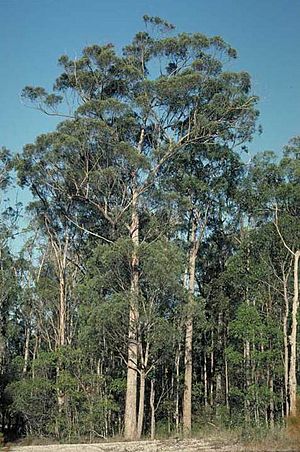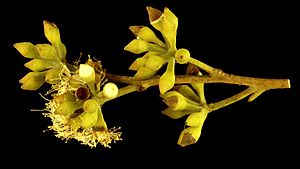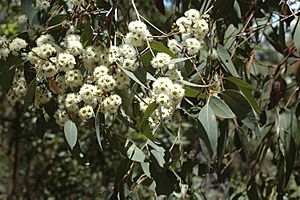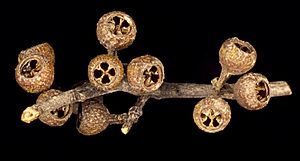Thick-leaved mahogany facts for kids
Quick facts for kids Thick-leaved mahogany |
|
|---|---|
 |
|
| Scientific classification | |
| Genus: |
Eucalyptus
|
| Species: |
carnea
|
| Synonyms | |
|
|
Eucalyptus carnea, often called the thick-leaved mahogany or broad-leaved white mahogany, is a special tree found only along the coast of eastern Australia. It has rough, stringy bark that covers its trunk and even its thinnest branches. This tree has long, curved leaves, and its flower buds grow in groups of seven to eleven. When it blooms, you'll see white flowers, and later, it produces fruit that looks like a small cup.
What Does the Thick-Leaved Mahogany Look Like?
The Eucalyptus carnea is a tall tree that can grow up to 25–30 metres (82–98 ft) high. That's about as tall as a seven-story building! It has rough bark that is grey or brownish and feels stringy or fibrous. This bark covers the whole tree, from the main trunk to the smallest twigs.
Young trees and new shoots have leaves that grow in pairs. These leaves are shaped like a spear or are slightly curved. They can be 80–200 mm (3.1–7.9 in) long and 35–100 mm (1–4 in) wide, and they have a different shade of green on each side.
As the tree gets older, its leaves change. Adult leaves are also spear-shaped or curved, about 80–170 mm (3.1–6.7 in) long and 17–40 mm (0.7–2 in) wide. They grow on a small stem called a petiole, which is about 10–20 mm (0.39–0.79 in) long. One side of the leaf is bluish-green, and the other side is a lighter green.
The flowers grow in groups of seven, nine, or eleven. They appear in the leaf axils (the spot where a leaf joins the stem). Each group of flowers grows on a stalk called a peduncle, which is about 10–22 mm (0.39–0.87 in) long. Each individual flower bud has its own tiny stem, called a pedicel, about 3–7 mm (0.12–0.28 in) long.
The mature flower buds are oval or spindle-shaped, about 6–7 mm (0.24–0.28 in) long and 3–4 mm (0.1–0.2 in) wide. They have a cone-shaped or slightly beaked cap called an operculum. This tree mainly blooms from September to November, and its flowers are white.
After the flowers, the tree produces fruit. The fruit is a woody, cup-shaped or rounded capsule. It is about 3–7 mm (0.12–0.28 in) long and 5–8 mm (0.2–0.3 in) wide.
How Did This Tree Get Its Name?
The Eucalyptus carnea was officially described for the first time in 1906 by a botanist named Richard Thomas Baker. He studied samples collected near the Richmond River by William Baeuerlen. Baker published his description in a scientific paper called Proceedings of the Linnean Society of New South Wales.
The second part of its scientific name, carnea, comes from a Latin word meaning "of flesh." This might refer to the color of the tree's inner wood, called heartwood.
Eucalyptus carnea belongs to a group of trees known as the "white mahogany" group. Other trees in this group include E. acmenoides, E. mediocris, E. apothalassica, E. helidonica, E. latisinensis, E. psammitica and E. umbra.
Where Does This Tree Grow?
The thick-leaved mahogany tree grows in forests. It prefers shallow soil. You can find it in an area stretching from Gympie in Queensland down to the Hunter River in New South Wales.




